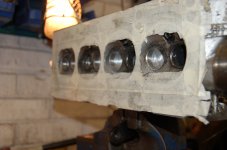Hi Oldschool, you meant aerodynamics, I imagine. Hydrodynamics is fluid dynamics applied to liquids. Ports (well, certainly inlets) follow all the normal of fluid behavioural principles.
The flow problems in inlet ports have an aerodynamic solution, there is only ever one aerodynamically correct solution unfortunately, everything else generates a loss, but finding it is very hard indeed on some heads, especially sidedrafted ones, and can sometimes only be derived by test after test and tiny incremental removal and reshaping.
The difference between gain and loss can be invisible to the human eye even with use of accurate templates.
I worked on Peugeot 205GTI heads during the latter part of last year. One was scratch-prepped, the other a big-name one already prepped that needed a seat replacing and gains if possible. And I had a scrap one to play with so I had the best of all worlds, but they still tied me in knots for weeks. With those heads every single mod has to be tested with valve in, I did over 80 development tests, each test and mod took about 1/2 hr, so you can see how difficult it can be. Slowly the 205 head gave up its secrets, and I not only enhanced my own results but bettered those of the previously prepped head.
I've started trying to get some more detailed info onto my site, wish I had more time. eg: see
http://www.guy-croft.com/page16.html
Now - FWIW my exp tells me that:
1. A thin contact face on the valve with a wide contact face on the seat is OK
2. Matched for size valve and seat contact face is good
3. Thin seat and wide valve contact face is bad
4. Super thin contact face and valve seat are bad
5. 35 thou per inch of inlet valve to 60 thou per inch seem to work fine.
6. A valve back-grind from 45 to 30 deg always helps flow.
7. Flow thru the valve throat must equal port flow, if the throat is too small a big port won’t flow and vice-versa
8. Sharp edges in the throat say, with 45 deg seat, 70 deg throat work can better than radiused edges.
(Some of these rules don't apply per se to blown engines BTW)
Moreover - The turn in the section between port and throat (esp. around the short side radius) will always reduce the flow significantly due to turbulence and drag, reverse flow even, so that the apparent flow potential of the port will never be realised in terms of net flow thru the seat (except on very heavily downdrafted engines, eg F1). There is thus a point in port enlargement beyond which increased size will not yield more flow, only a drop in velocity. A 36mm pipe (try it) will flow about 180 cfm at 10", more than any head I know of with 36mm valve throat. A 36mm port will flow the same, but put the two together and the flow loss is huge and all you can do is try to miminise it.
I have yet to find anything that works better than 45 seat and 70 deg throat. I've tried other valve angles ad nauseam, could not better it and mostly the other layouts were worse.
The inner region and valve/seat/throat are very closely interlinked in terms of what works best. Valve shape is a hugely influential factor and you would be well advise to determine the results on a scrap head. Sidedraft heads seem to work best with penny on stick designs and downdrafted heads (valves inclined at 20-25 deg or more to vertical) seem to prefer more of a tulip design, but this should not be taken as a golden rule, as the one thing I do know for sure is that every engine is different and has to be tested to death to get the best results.
There are two reasons why top race engines are now almost all done by
1. Modelling by computational fluid dynamics
2. Flow bench confirmatory testing
3. CNC machining followed by hand finishing
4. Dyno testing and track testing with full data log.
This process gives the nearest to 'perfect' aerodynamic port shape, and repeatability, ie: all heads flow the same.
Regards,
GC
I write on forums for fun only and to proffer a bit of experience. I hope that what I write helps someone somewhere. If this is out of place here, feel free to delete or shift it, thanks.



